by Winding Pathways | Jun 30, 2016 | Birds, Nature
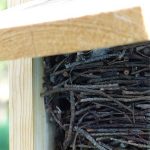
The wrens use just their beak and claws to layer sticks and then feathers from other birds to make a cozy safe nest to raise young.
Just ten days ago the wren parents fledged the babies from the box on our deck. After we knew they were safely gone, Rich unbolted and cleaned out the next. What an amazing feat of engineering! With just a beak and claws, the wrens fashioned a comfy, warm home to sit on eggs and raise young. All was quiet for the rest of the week. The birds had all dispersed.
The past few days we have noticed activity in the High Bush Cranberry, on the deck, around the pond and at the feeders. Today, definite mating activity as up to five wrens competed for attention, displayed mating moves and two began rebuilding the box on the deck. In and out flew the wren gathering small sticks by the pond and placing them in the box. So, it looks like a pair plans to start one more brood.
Later in the year, the Carolina Wren will grace our yard. Larger and more distinctive, it seems to fare well in Iowa even in cold weather.
by Winding Pathways | Jun 30, 2016 | Birds, Nature
Late June into mid-August is exciting, dangerous and nostalgic for all creatures fledging – including people!
Birds and wild creatures have mated, nested, and are raising young. For some this takes weeks, months or years (kids). This spring has been fun watching the rabbits and variety of birds growing up and fledging. At the same time, Marion has been reading the Jean Craighead George series: My Side of the Mountain, The Far Side of the Mountain, and Frightful’s Mountain. About experiencing the power of observation as nature unfolds.
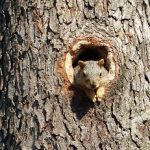
It’s a long way down, Mom.
A squirrel family nested in a hole in an oak within view of the back deck. One spring day we spotted a young squirrel just looking out. Soon after, we saw young in all the fruit trees hanging upside down. We think that their dexterity must be developed in part by their having been gestated in the moms leaping from branch to branch and raised in wind whipped trees.
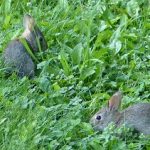
Bunnies are on their own as soon as the mother weens them.
Recently, Rich spied a young rabbit family nest under a maple tree. This spring most ground reared animals like bunnies, turkeys and pheasants were safe from storms. So, the rabbits are prolific! They are hilarious to watch in different stages of growth from naive hand sized bunnies to teen-sized rabbits to adults. They often hold convention on our front and back lawns. They seem alert and always near tall grass because the owl population has grown – we hear them hooting at dusk.
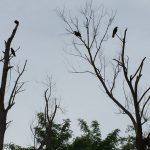
Crow family fledging
Crows suddenly seem to appear yet they have been around all the time. In tall trees a family hangs out watching for food. On the ground you can tell the adults and young by watching who feeds whom. At some point the adults say, “You are on your own!” Off they fly and the young have to survive.
Wrens and Cardinals are always a treat to watch. The one nest off our back deck gave us great viewing as the pair bonded, set up home, fed each other as one sat on eggs, and the babes grew from a chittering brood to fully fledged and out of the nest in a matter of weeks. Now the box and deck are strangely and sadly quiet. But, the fledglings frequent the shrubs nearby, still entertaining us.
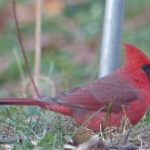
Cardinal on Ground
Cardinals are perhaps my favorite only because I watched a family grow and fledge the same time our daughter graduated and left for college.
All the animals are amazing to watch. They are smart, adaptable and instructive. We learn a lot watching them. By next spring their numbers will be decreased as many die from predation, accidents, weather and interactions with humans. Meanwhile, keep your eyes and ears alert for these incredible creatures with whom we share this ecosystem.
-
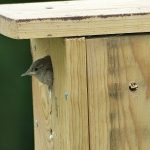
-
Contemplating the world.
-
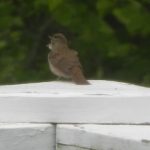
-
It’s a big world out there.
-
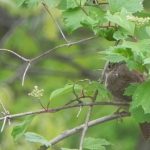
-
Contemplating testing its wings.
by Winding Pathways | Jun 30, 2016 | Nature, Reflections/Profiles, Wonderment
Take in some great summer reading! Cornelia (Connie) Mutel, Winding Pathway’s good friend, sent us her most recent book, A Sugar Creek Chronicle: Observing Climate Change from a Midwestern Woodland.
Her book weaves three themes together that encourage readers to enjoy woodlands and embrace actions to lessen climate change.
Connie is a gifted nature writer who transforms her observations into delightful prose that reminds us of Joseph Wood Krutch‘s style. Her book is a pleasant way to learn about and enjoy a woodland as it progresses through seasons and responds to weather.
As the title implies, she relates changes in her woods caused by climate change. Nature is neither politically correct nor untruthful. A knowledgeable observer, as the author is, recognizes alarming signals of a warming planet communicated by vegetation and wildlife but often unnoticed by those less informed.
Finally, she weaves her personal story into a blend of woodland delight and climate concern. She bemoans her reliance on fossil fuel to get to and from work and to run her air conditioner, expresses joy at sharing woodland hours with grandchildren, and relates her long term cancer relationship with earth health.
Sugar Creek Chronicle is a lovely book about a serious environmental threat. Perhaps its major virtue is how the author blends joy of nature’s beauty, concern about the planet’s future, and a love of life that encourages readers to lessen the impact of climate change.
University of Iowa Press Bur Oak Series
www.uiowapress.org
ISBN: 978-1-60938-395-4
Marion’s all time favorite summer series is by Jean Craighead George: My Side of the Mountain, The Far Side of the Mountain, and Frightful’s Mountain.
Other good books to read this summer:
The Intelligent Optimist”s Gide to Life. Jurriaan Kamp. Berrett-Koehler Publishers, Inc. 2014. ISBN: 978-1-62656-275-2
Places of Quiet Beauty: Parks, Preserves and Environmentalism. Rebecca Conrad. University of Iowa Press. ISBN: 0-87745-558-9
Their Name Is Today: Reclaiming Childhood in a Hostile World. Johann Christoph Arnold. Plough Publishing House. ISBN: 978-0-87486-630-8
by Winding Pathways | Jun 18, 2016 | (Sub)Urban Homesteading, Energy Efficiency
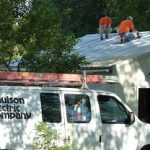
An excellent company to work with.
Just before the summer solstice Winding Pathway’s new photovoltaic system began producing electricity.
A few months ago Paulson Electric Company in Cedar Rapids, Iowa, did an analysis of our home and provided us with an airtight proposal. Thanks to tax credits from both the US and Iowa governments we could install a system that will produce about half our electricity without combustion, moving parts, or noise. We’ll receive at least a seven percent return on our invested money, better than we can do at any bank or the stock market.
Our system is net metered. Sun hitting the solar panels produces DC electricity that inverters convert to AC. It flows through our electric meter. When we are producing more electricity than we’re using, typically on sunny summer days, our meter runs backward. When we’re using more than it’s producing – at night and during winter’s short days – the meter runs forward. Each month we pay Alliant Energy, our utility, the net.
We love solar electricity. It takes some natural resources to construct and move the system but once in place it will last at least 25 years and continue producing electricity without burning fossil fuel or causing air pollution. And it saves us money.
Iowa is a national renewable energy leader with over 31% of the state’s electricity being produced by wind or solar. Within four years it will be around 40%. Our state isn’t alone. Solar and wind power are growing everywhere. They are a way for people to enjoy the benefits of electricity without worsening climate change.
The windmill graphic on my Iowa driver’s license is a fitting symbol for the energy revolution sweeping the state.
When conventional fuel prices spiked years ago Iowa leaders became concerned that vast amounts of money were leaving the state to buy oil, natural gas and coal.
Iowa may lack petroleum but has incessant wind and plenty of sunshine. Harnessing these limitless resources seemed prudent and governments, utilities, environmentalists, manufacturers and nonprofits converged to position Iowa into its current leadership role in renewable energy. “We had strong public policy and leaders like then governor Tom Vilsack (now US Secretary of Agriculture) who were interested in making it happen and worked with people to get it done. Wind manufacturing was a target for economic development. We added renewable energy training at community colleges and passed production tax credits to encourage small scale locally-owned wind and solar projects,” said State Senator Rob Hogg.
Today 31% of Iowa’s electricity comes from the wind and sun. It will likely reach 40% by 2020 propelled in part by declining costs of renewable installations. In 1983 it cost 55 cents to produce a kilowatt of wind electricity. Today it’s a nickel. Photovoltaic costs, although higher than wind, are also tumbling.
Iowa’s renewable energy boom arrived with little controversy. Farmers receive royalty payments for each turbine on their property and about 6000 Iowans are now employed in the wind industry assembling turbines, constructing and maintaining wind farms, and providing equipment to support the industry. So strong has employment grown that Kirkwood Community College in Cedar Rapids erected a massive turbine that produces 24% of its electric consumption and offers an Associate Degree of Applied Wind Maintenance. “Our graduates have been hired by many utilities and are now maintaining turbines all over the world,” said Tom Kaldenberg, Associate Vice President.
Van Meter Industrial is a wholesale electrical supply distributor. “Five years ago we had one employee serving the photovoltaic market. Now we have five. At least 47 Iowa companies are involved in the solar energy supply chain and at least 680 Iowans are employed in installing, marketing, and supplying the solar industry,” said Brad Duggan, Van Meter’s Renewable Energy Product Manager.
-

-
An excellent company to work with.
-
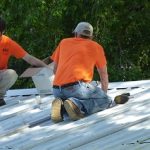
-
Workers begin on the roof installing the framework. They watch the weather for at least two consecutive days of low wind and no storms to complete this part of the job.
Renewable energy isn’t perfect and won’t completely replace conventional power generation. Calm occasionally envelops usually gusty Iowa and the sun refuses to shine at night. Wind turbines kill birds and bats, but this threat has diminished. Some people simply don’t like windmills, although I’ve heard few Iowan’s express this.
Wind and solar reduce the negative impact of burning fossil fuels. Once in place these renewables release no emissions to the atmosphere and don’t pull water from rivers or the ground. There’s no need for dams to block fish movement and no concern about a nuclear catastrophe or mercury and acid raining down into lakes and the ocean.
There are significant economic and legal differences between wind and solar electricity. Massive wind farms are owned by utilities and like coal or nuclear plants the utility produces and sells the power. To a consumer there isn’t any difference between buying electricity produced at a coal plant or wind farm. In contrast photovoltaics and the electricity they produce are owned by individuals.
Wind often blows all day and night, while the sun only works the day shift. To completely rely on solar electricity a homeowner needs a stand-alone system to charge batteries when the sun’s shining and yield electricity when it’s not. Battery systems are expensive and normally only cost effective if a home is a long distance from the grid.
Increasingly common are grid intertie net metered systems where electricity flows both ways through a meter. There is no power storage. Essentially the grid acts as a battery. When a home is producing more electricity than being used power flows outward to the grid, running the meter backward. At night electricity is pulled in and the meter runs forward. At the end of the month the utility bills the customer for the net amount used.
Over 20 years ago, while Director of the Indian Creek Nature Center, I acquired photovoltaic panels that Jimmy Carter erected on the White House and Ronald Reagan later removed and put in storage. I wanted to create Iowa’s first net metered photovoltaic system but there was no legal mechanism for a grid inter tie. Fortunately my utility, Alliant Energy, was cooperative and helped legally and technically connect the system with their grid. This led to a permanent legal mechanism that enables property owners to net meter either wind or solar generated electricity.
Although small our system cut the electric bill by 41% and the Nature Center is now constructing, with Alliant’s help, a new building that will produce more electricity than it consumes, a concept that can be incorporated into many structures.
-
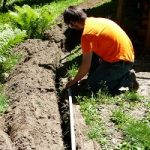
-
The wire is safely tucked inside this pipe.
-
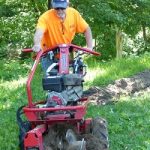
-
Trenching takes time and skill.
-
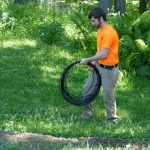
-
After the trench is dug, the coil is unwound and settled into the trench.
Because utilities don’t produce home or business generated solar electricity they face a dilemma somewhat akin to electric cars, where the owner uses roads but does not pay gasoline taxes needed to maintain them. Utilities must sustain their grid but can’t sell electricity they don’t produce. Essentially net meter customers have free access to the grid. Utilities are likely to eventually charge a grid access fee.
Economics are driving renewable energy expansion, at least in Iowa. Cedar Rapids based Paulson Electric recently prepared a bid to place a photovoltaic system on our home. For a cost of $13,150 a new system will produce 93% of our electric consumption. We will receive state and federal tax credits of about $6312, reducing our cash cost to $6838. The payback on investment is about 11.2%. That’s far more impressive than the microscopic interest we receive from our traditional investments.
Renewable energy isn’t pie in the sky but In Iowa it has created significant employment while reducing environmental threats caused by hydro, nuclear, and fossil fuel. It is a model that is expanding across the country and holds great promise for a cleaner future.
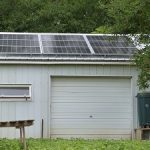
Soaking up the sun.
For information Contact
Wind: American Wind Energy Association at www.awea.org
Solar: Solar Energy Industries Association at www.seia.org
Solar Electric Power Association at www.solarelectricpower.org
Paulson Electric in Cedar Rapids at www.paulsonelectric.com
Van Meter Industrial at https://www.vanmeterinc.com/
by Winding Pathways | Jun 10, 2016 | Bugs, Nature, Pests
We are proud of and fortunate that our yard is home to a wide array of fascinating plants and wildlife.
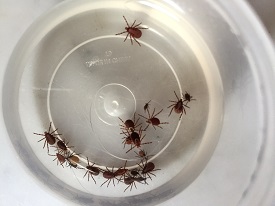
Only a good friend would know that we want pictures of creepy crawlies and save them for us for our blog!
But, last year Rich encountered a wild animal that he wishes he’d avoided. A deer tick found and bit him, although he never saw the tiny eight legged creature. A classic symptom of Lyme Disease is a red rash shaped like a bull’s eye. But Rich never had one. Instead he became overwhelmed with lethargy.
“I never felt sick, just tired, and kept thinking I’d be fine in a day or two,” he said.
But the fatigue dragged on for months, so he called our family physician who urged him to come right in. She gave him a thorough check over, and prescribed a chest X Ray and a Lyme Disease blood test.
Rich did both that afternoon. Within hours the doctor called to say the X ray revealed pneumonia and prescribed an antibiotic. Four days later the Lyme test came back positive and she prescribed a 21 day regime of amoxicillin, a different antibiotic.
“In just a few days the medicine worked and I felt better. Within a month the fatigue evaporated and the only lingering symptom was mild knee pain that may or may not have been caused by Lyme. I’m 66 and have a bit of osteo arthritis,” he said.
Rich was lucky. A year after the Lyme diagnosis he’s doing fine. Fortunately, his doctor prescribed the correct tests and medication and caught the disease early. Many people are less fortunate and suffer long term pain, fatigue and other symptoms.
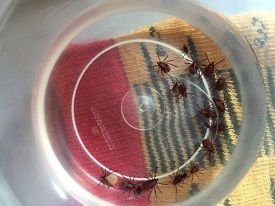
Ticks measured against eighth inch markings.
Lyme disease is transmitted by the deer tick, a tiny eight legged animal that is increasingly common. Ticks live in tall grass and brushy areas, and our yard at Winding Pathways has both. We walk through other places where a tick could have found Rich. Ticks usually crawl around on a person for several hours before digging through the skin and feeding on blood. A wandering tick that has not penetrated the skin cannot transmit disease. Pluck it off and flush it down the toilet or drop it into soapy water.
It’s easy to be scared by negative publicity about Lyme Disease and stay inside. While the disease is serious and is not to be taken lightly, advice to avoid brushy and grassy places must be put into context. These places are beautiful and are homes to interesting wildlife and plants. They are places to get exercise. Even after contracting Lyme we spend part of our time in tick habitat, but we are cautious.
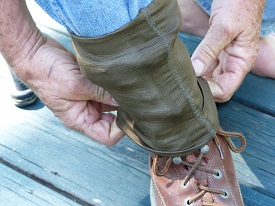
Gaiters fit snugly over boots and pants to deter ticks.
Here’s what we now do:
- Spray our clothes, ankles, and wrists with insect repellent containing DEET.
- When outside for a while we don special tick resistant gaiters (sometimes called spats) that make it hard for a tick to get under pants legs. We bought them from Forestry Suppliers for $13.

Permethrin-based spray can be bought at most stores that sell insect repellent.
We spray the gaiters with special repellent containing Permethrin that both repels and kills ticks Apply this to clothing, not skin. It is effective for at least two weeks so we don’t launder the gaiters but reapply the spray a couple of times a month.
- Change and launder clothes and shower when we’re done outside. Tiny deer ticks are tough to spot, but we do a body tick check as part of showering.
- Pay attention to our bodies. If we spot a dug-in tick or bulls-eye rash or experience lethargy or joint pain we’ll get to our doctor right away. No procrastination.
Rich emerged from Lyme Disease cautious and smarter but not afraid of being outside in beautiful and interesting places.
FOR MORE INFORMATION
The Internet has great information on ticks and Lyme Disease.
Two of our favorite information sites are:
Centers for Disease Control and Prevention.
WebMD type in the search bar Lyme Disease.
We ordered our tick and chigger gaiters from Forestry Suppliers.
Permethrin based spray can usually be purchased in stores that sell insect repellent. Be sure to read the label.


















